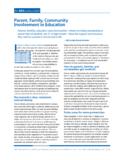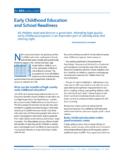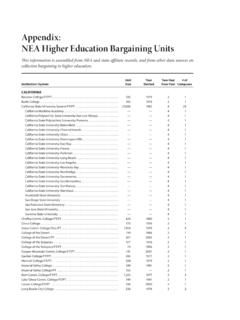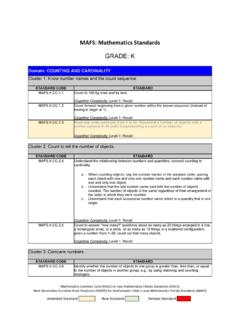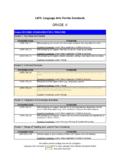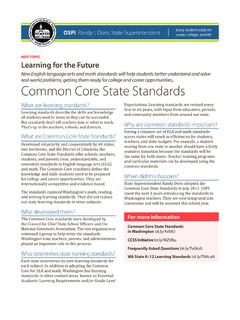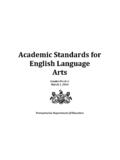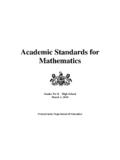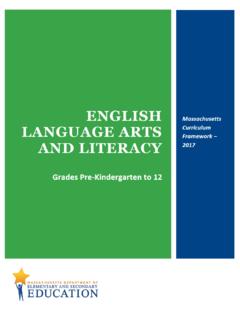Transcription of Common Core State Standards: A Tool for …
1 An NEA policy brief NEA Education Policy and Practice Department | Center for Great Public Schools | 1201 16th St., NW, Washington, 20036 For many years, there have been efforts to pro-mote the development of national standards for education in the United states . For several reasons, including concerns about potential ideolog-ical bias and political pressure, those efforts did not gain wide support. In addition, there is no research or evidence indicating that national standards are essen-tial for a nation s students to be high achievers. However, the potential for a set of Common educational goals to help states focus resources and system planning remained attractive to many education policy the Spring of 2010, the National Governors Association (NGA) and the Council of Chief State School Officers (CCSSO) completed the a proj-ect to develop Common core State standards (CCSS).
2 Leading education organizations, such as the National Education Association (NEA), the College Board, Achieve, and ACT agreed to become partners with NGA and CCSSO. Members of major teacher organizations, NEA, the American Federation of Teachers (AFT), the International Reading Association (IRA), the National Council of Teachers of Mathematics(NCTM), and the National Council of Teachers of English(NCTE) served as review groups. Their comments led to a number of changes for the final draft of the CCSS. How were the Common core State standards developed?Students are entering into a world that most of us would have found hard to contemplate even 10-15 years ago. Whether students enter post-secondary education, the workplace, or both, articulating what students need to know and be able to do in order to be successful in both college and a career was central to the development of the Common core standards .
3 The first part of the effort entailed drafting College and Career Ready (CCR) standards in English language arts and mathematics. The main participants in this initial stage included CCSSO and NGA as the leaders and coordinators, the College Board, ACT, and Achieve. After the CCR standards were drafted, many teach-er groups, including NEA, AFT, IRA, NCTM, and NCTE, weighed in with comments and concerns. As a result of those comments, changes were made to the CCR standards before the final draft. After the CCR standards were approved by states , work began on the Common core State standards (CCSS) for grades k -12. Throughout the develop-ment process, drafts of the CCSS were reviewed by an NEA team of National Board Certified teachers as well as teachers from the content organizations. A system of input groups guided the development of the CCSS. A Development Group drafted and Common core State standards : a tool for Improving Education We believe that this initiative is a critical step in State efforts to provide every student with a comprehensive, content rich education.
4 These standards can support the collaboration across states and stakeholders in providing programs, resources and policies that will help overcome the weaknesses and inequities in our schools today. NEA President Dennis Van Roekelrevised the standards . A Feedback Group informed the work of the Development Group by provid-ing guidance and input to drafts of the standards . A Validation Committee reviewed the standards to ensure the standards were research-based and evidence-based. This group was completely inde-pendent from the Development Group. What do the Common core State standards cover?
5 The CCSS cover English language arts and math-ematics. While NEA advocates addressing and set-ting goals for all curricular areas, it acknowledges that initial development of Common standards must start with a feasible task and addressing only these two content areas was challenging but manageable. Efforts are now underway to begin developing Common State standards for science and social studies. If having Common standards proves to be a support for education improve-ment, Common State standards should be devel-oped for all content areas, including the arts and physical standards for English Language ArtsThe Role of Increasingly Complex TextsThere are some key characteristics and organiz-ing principles for the CCSS in English language arts. One is the guiding notion that reading com-prehension and writing composition skills do not change much after students began to read and write; rather, what changes are the complexity of the texts they read and the tasks or purposes for reading.
6 For example, a sixth grader could read A Wrinkle in Time and identify the relatively concrete themes of the book without using much interpretation or abstraction. A student in a high school literature course would need to use much more abstraction, synthesis, and interpretation to identify the themes in To Kill a Mockingbird. For a detailed explanation of the role of text complexity in reading see Appendix A of the English language arts Progressions A key organizing principle for the English language arts CCSS is the notion of learning progressions. Learning progressions can be defined as descrip-tions of the successively more sophisticated ways of thinking about a topic that can follow one another as children learn about or investigate a topic over a broad span of time ( , 6 to 8 years). 1 Here is an example of a portion of a learning pro-gression from the CCSS for Reading for Literature.
7 NEA Education Policy and Practice Department | Center for Great Public Schools | 1201 16th St., NW, Washington, 20036 2 An NEA policy brief Validation Commit tee Reviewed standards for: Research-based Evidence-basedDevelopment Group Drafted and Revised StandardsFeedback Group Provided Feedback and GuidanceEducation Organizations Review and Provide Feedbackg1oCollege and Career Ready Standard 6 Grade 4 Reading Standard for Literature 6 Grade 5 Reading Standard for Literature 6 End Goal of K -12 EducationWhat a Student needs to Be Able to Do at the End of Grade 4 to Be on Track to Achieve the End GoalWhat a Student needs to Be Able to Do at the End of Grade 6 to Be on Track to Achieve the End GoalAssess how point of view or purpose shapes the content and style of a the point of view from which different stories are narrated, including the difference between first and third person how a narrator s perspective or point of view influences how events are is an example from the standards for Informational Text that follows the same CCR standard 6 cited above.
8 It demonstrates a learning progression applied to informational rather than literary reading use of learning progressions such as those in the CCSS in order to outline goals for curriculum and instruction is a practice commonly used in many countries that perform well on international assessments of academic achievement. It has the potential to provide greater coherence across grade level standards as well as research-based learning standards for MathematicsIn the mathematics, the CCSS standards include an overarching set of standards for mathematical practice that are goals and guides for instruction at all standards are:1. Make sense of problems and persevere in solving Reason abstractly and Construct viable arguments and critique reasoning of Model with mathematics5. Use appropriate tools Attend to Look for and make use of Look for and express regularity in repeated overarching aim of the CCSS in mathematics for grades K through 7 is to prepare students to succeed in algebra in grade 8.
9 The K-8 standards are organized in domains that include: The standards for high school are organized in conceptual categories that align with Is Special about These standards ? These standards were developed with the aim of establishing Common educational goals that states could share. The standards were designed to be: Focused, coherent, clear, and rigorous Internationally benchmarked Anchored in college and career readiness Evidence and research-based. An NEA policy brief NEA Education Policy and Practice Department | Center for Great Public Schools | 1201 16th St., NW, Washington, 20036 3 Counting and Cardinality (K only) Operations and Algebraic Thinking (K-5) Number and Number Operations in base 10 (K-5) Number and Operations Fractions (3-5) Measurement and Data (K-5) Geometry (K-8) Rations and Proportional Relationships (6-8) Expressions and Equations (6-8) Statistics and Probability The Number System (6-8) Number and Quantity Algebra Functions Modeling Geometry Statistics and ProbabilityCollege and Career Ready Standard 6 Grade 3 Reading Standard for Informational Tex t 6 Grade 4 Reading Standard for Literature 6 Assess how point of view or purpose shapes the content and style of a what is presented in the text with relevant prior knowledge and beliefs, making explicit what is new and an eyewitness account to a second hand account of the same event or topic.
10 An NEA policy brief NEA Education Policy and Practice Department | Center for Great Public Schools | 1201 16th St., NW, Washington, 20036 4 The standards articulate broad, high goals for each grade, rather than strings of specific enabling skills. While they are focused, they leave flexibility for multiple ways of achieving them. They guide, but do not restrict curriculum. Because they are fewer, they are manageable for teachers. They are expressed clearly and in terms that parents and the public can understand. For example, Writing Standard 7 for Grade 5 is: Conduct short research projects that use several sources to build knowl-edge through investigation of different aspects of a topic. The standards are internationally benchmarked through comparisons to standards of countries that perform well on international assessments and through the use of standards from other coun-tries as standards are anchored in college and career readiness through two vehicles.
